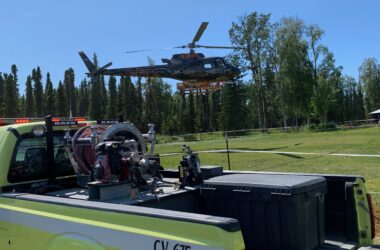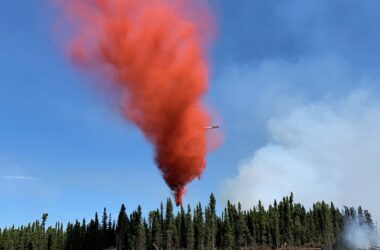The Alaska Energy Authority (AEA) has secured $206.5 million for Grid Resilience and Innovation Partnership (GRIP) Topic Area 3: Grid Innovation through the United States Department of Energy Grid’s (DOE) Grid Deployment Office (GDO). A cost share of 100 percent, or $206.5 million, is required for a total project amount of $413 million.
The awarded Railbelt Innovation Resiliency (RIR) project will construct a High Voltage Direct Current (HVDC) submarine cable to serve as a parallel transmission route from the Kenai Peninsula to Anchorage, creating a much-needed redundant system in case of disruptive events. In addition, the RIR project will provide funding for multiple battery energy storage systems (BESS) within the respective serving areas of the Railbelt utilities, with a focus on the central and northern regions of the Railbelt electrical grid. The project is estimated to take eight years to complete.
“Right now, we have what’s called a constrained system, meaning it doesn’t affect HEA or the Kenai Peninsula as much as it affects other Railbelt utilities such as CEA, MEA, and Golden Valley,” said Homer Electric Association Director of Member Relations, Keriann Baker. In a call to KSRM, Baker offered a more simplified explanation of the RIR project’s function and benefit, beginning with the afore mentioned concept of constraints on the current system.
We all [Railbelt utilities] share in a project — [the] Bradley Lake project,” Baker explained during the call. “And since the power gets created and generated down here on the Kenai, and then it travels North up to these other communities, for us there’s really not a huge issue because we’re right here. But the problem is this system is constrained, so we have a lot of line losses, and we can’t transfer a ton of it.”
As Baker describes it, the transference limitation of the current system is like driving to Anchorage on a narrow, two-lane road. In effect, you will eventually arrive, but it’ll take a lot more time to get there, and you’ll expend a lot more fuel in the process. The RIR project will add a second, multi-lane highway along the Railbelt by which the shared energy will transfer more efficiently and without the same line losses. Or, as Baker puts it, “We’re going to have a second redundant path off of the Kenai Peninsula, and so we’ll be able to transmit much faster and then have energy coming back to us by de-constraining the system and having one more path off the peninsula.”
The subsea line is only one portion of the project, however. The other half is the battery energy storage systems, whose function is to act primarily as — again, layman’s terms here — a stabilizing, or regulating agent for the energy being generated. Speaking generally, there are two sources by which the energy used by electrical companies is generated: firm and intermittent.
A firm source is something like natural gas firing. Baker describes this as a “push button” source. Meaning, push button; get power. The output from a firm source is consistent. Conversely, intermittent sources, like solar, wind, or tidal, do not produce energy at consistent output levels. The function of the battery energy storage systems, then, is two-fold. First, as a stabilizing agent, the systems take in the irregular input levels of the various sources, stores them, and provides a consistent energy output into the transfer system. Second, as a storage unit, a battery storage provides backup energy when input levels are reduced.
According to Baker, this efficiency offers a company like Homer Electric the ability to better meet standards of energy reliability at a reduced cost to the providers. In essence, they want to make sure the lights are always turning on when someone flips the switch. “Our mission is to create the lowest cost energy that is reliable and safe,” she said. “We want the lowest cost way to produce that energy for when people turn on the lights.”
Elsewhere, energy company executives from around the state offered praise for the RIR project with the announcement of the $206 million Infrastructure Bill appropriation.
“The Railbelt transmission system is the largest electrical grid in Alaska and critical for the continued support of statewide economic and community development,” said AEA Board Chair Dana Pruhs. “Over 75 percent of Alaska’s population depends on the Railbelt, making it one of the state’s most important pieces of infrastructure. Securing this historic funding is a real game-changer in our ability to transform the Railbelt.”
“Thanks to millions in federal funding, we have the opportunity to elevate Alaska’s aging Railbelt electrical grid to today’s industry standards,” said AEA Executive Director Curtis W. Thayer. “I am extremely proud of AEA’s team and the Railbelt utilities’ partnership. Through joint cooperation, we can improve resilience and energy security, diversify the state’s energy portfolio, and accelerate the use of renewables and clean power.”
“The State of Alaska is on the precipice of investing hundreds of millions of dollars in upgrades to its dated transmission infrastructure thanks to the collaboration between the Railbelt utilities, the Alaska Energy Authority, and Alaska’s Congressional Delegation. Working together this team secured federal funds to build a second transmission line from the Kenai Peninsula to Anchorage and install much-needed battery storage into the grid. These investments will allow power to be produced at the lowest cost location for the benefit of all Alaskans,” said Homer Electric Association General Manager Brad Janorschke.
As part of the Bipartisan Infrastructure Law, the GDO is administering a $10.5 billion GRIP Program to enhance grid flexibility and improve the resilience of the power system against the growing threats of extreme weather and climate change. Programs such as GRIP are intended to accelerate the deployment of transformative projects that will help to ensure the reliability of the power sector’s infrastructure, so all American communities have access to affordable, reliable, clean electricity anytime, anywhere.
Whether or not residents will be able to expect reduced rates once the RIR project is completed is yet to be determined, and would probably have a lot to do with what happens in the American and global economies over the next eight years. Nevertheless, one of the vital energy systems for both the Kenai Peninsula, and Alaska, is getting a long overdue, but very necessary upgrade.






